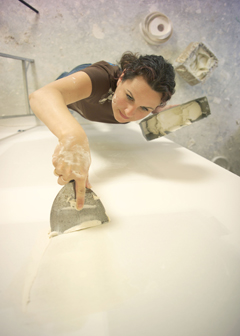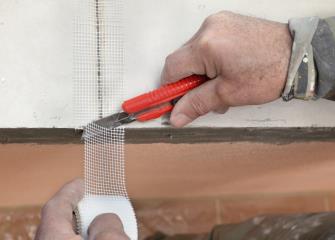Drywall Installer, Ceiling Tile Installer, or Taper
Drywall Installer, Ceiling Tile Installer, or Taper
Does this career fit your work personality?
Begin The Career Assessment Test- Best Fitting Careers
- Work Personality Strengths
- Work Style Preferences
- and more
Job Outlook
Overall employment of drywall installers, ceiling tile installers, and tapers is projected to show little or no change from 2022 to 2032.
Despite limited employment growth, about 9,000 openings for drywall installers, ceiling tile installers, and tapers are projected each year, on average, over the decade. Most of those openings are expected to result from the need to replace workers who transfer to different occupations or exit the labor force, such as to retire.
What Drywall Installers, Ceiling Tile Installers, and Tapers Do
Drywall installers and ceiling tile installers hang wallboard and install ceiling tile inside buildings. Tapers prepare the wallboard for painting, using tape and other materials. Many workers both install and tape wallboard.
Duties
Drywall installers, ceiling tile installers, and tapers typically do the following:
- Measure, mark, and cut drywall panels according to design plans
- Fasten panels and tiles to support structures
- Patch, trim, and smooth rough spots and edges
- Apply tape and sealing compound to cover joints between wallboards
- Add coats of sealing compound to create an even surface
- Sand all joints and holes for a smooth, seamless finish
Drywall and ceiling tile installers place panels over the walls and ceilings of interior rooms in buildings. The panels cover insulation, electrical wires, and pipes; dampen sound; and provide fire resistance. Tapers prepare the drywall for finishing.
Workers may use mechanical lifts or stand on stilts, ladders, or scaffolds to hang and prepare ceilings. After hanging wallboards, workers use trowels to spread coats of sealing compound over cracks, indentations, and other imperfections. Some workers use a mechanical applicator, a tool that spreads sealing compound on the wall joint while dispensing and setting tape at the same time.
Drywall installers are also called drywallers or hangers. They cut and hang the panels of wallboard. The tools they use include tape measures, straightedges, utility knives, and power saws.
Ceiling tile installers hang ceiling tiles and create suspended ceilings. Tiles may be applied directly to the ceiling, attached to furring strips, or suspended on runners that are connected by wire to the ceiling. Workers are sometimes called acoustical carpenters, because they also install tiles that block sound.
Tapers, also called finishers, prepare the drywall for covering by paint and wallpaper. Tapers apply paper or fiberglass mesh tape to cover drywall seams. They also smooth the tape after affixing it and apply a finishing compound to the tape.
In addition to performing new installations, many installers and tapers make repairs such as fixing damaged drywall and replacing ceiling tiles. The wall coverings applied to the finished drywall are installed by painters, plasterers, and paperhangers.

Work Environment

Drywall and ceiling tile installers held about 116,400 jobs in 2022. The largest employers of drywall and ceiling tile installers were as follows:
| Drywall and insulation contractors | 60% |
| Self-employed workers | 22 |
| Nonresidential building construction | 5 |
Tapers held about 18,100 jobs in 2022. The largest employers of tapers were as follows:
| Drywall and insulation contractors | 66% |
| Self-employed workers | 22 |
| Nonresidential building construction | 5 |
| Painting and wall covering contractors | 4 |
Drywall installers, ceiling tile installers, and tapers work indoors. The work is physically demanding. Workers spend most of the day standing, bending, or reaching, and they must often lift and maneuver heavy wallboard.
Work Schedules
Most drywall installers, ceiling tile installers, and tapers work full time.
Getting Started
How to Become a Drywall Installer, Ceiling Tile Installer, or Taper

Most drywall installers, ceiling tile installers, and tapers learn their trade on the job. A formal educational credential is typically not required to enter the occupation.
Education
There are no educational credential requirements for becoming a drywall installer, ceiling tile installer, or taper, although some employers prefer to hire candidates who have a high school diploma or equivalent.
A high school diploma or equivalent is typically required for workers starting an apprenticeship.
Training
Most drywall installers, ceiling tile installers, and tapers learn their trade on the job by helping experienced workers and gradually taking on more duties. They start by carrying materials and cleaning up and then learn to use the tools of the trade. They learn to measure, cut, and install or apply materials. They may start out working on less visible areas, such as closets. Their on-the-job training typically lasts up to 12 months.
A few groups, including the United Brotherhood of Carpenters, International Union of Painters and Allied Trades, and contractor associations, sponsor apprenticeship programs for drywall installers, ceiling tile installers, and tapers. Apprenticeships combine on-the-job training with technical instruction and typically last 2 to 4 years.
During their apprenticeship training, drywall installers, ceiling tile installers, and tapers learn a number of safety rules, many of which are standardized through the Occupational Safety & Health Administration (OSHA).
Advancement
Drywall installers, ceiling tile installers, and tapers may advance to become supervisors, general superintendents, project managers, or estimators. Workers may also choose to start their own business after gaining experience in the occupation.
Workers who join a union may also find career advancement opportunities within their union, such as becoming the business manager for a local chapter or becoming an instructor for the apprenticeship program.
Contacts for More Information
For details about apprenticeships or other work opportunities in this trade, contact the offices of the state employment service; the state apprenticeship agency; local contractors or firms that employ drywall installers, ceiling tile installers, and tapers; or local union–management finishing trade apprenticeship committees. Apprenticeship information is available from the U.S. Department of Labor’s Apprenticeship program online or by phone at 877-872-5627. Visit Apprenticeship.gov to search for apprenticeship opportunities.
For more information about drywall installers, ceiling tile installers, and tapers, visit
Associated Builders and Contractors
Association of the Wall and Ceiling Industry
Similar Occupations
This table shows a list of occupations with job duties that are similar to those of drywall installers, ceiling tile installers, and tapers.
| Occupation | Job Duties | Entry-Level Education | Median Annual Pay, May 2022 | |
|---|---|---|---|---|

|
Masonry Workers |
Masonry workers use bricks, concrete and concrete blocks, and natural and manmade stones to build structures. |
See How to Become One | $49,490 |

|
Carpenters |
Carpenters construct, repair, and install building frameworks and structures made from wood and other materials. |
High school diploma or equivalent | $51,390 |

|
Construction Laborers and Helpers |
Construction laborers and helpers perform many tasks that require physical labor on construction sites. |
See How to Become One | $39,520 |

|
Painters, Construction and Maintenance |
Painters apply paint, stain, and coatings to walls and ceilings, buildings, large machinery and equipment, and bridges and other structures. |
No formal educational credential | $46,090 |

|
Flooring Installers and Tile and Stone Setters |
Flooring installers and tile and stone setters lay and finish carpet, wood, vinyl, tile, and other materials. |
No formal educational credential | $47,890 |

|
Insulation Workers |
Insulation workers install and replace the materials used to insulate buildings or mechanical systems. |
See How to Become One | $47,980 |

|
Roofers |
Roofers replace, repair, and install the roofs of buildings. |
No formal educational credential | $47,920 |
